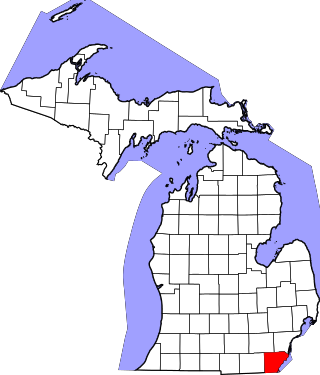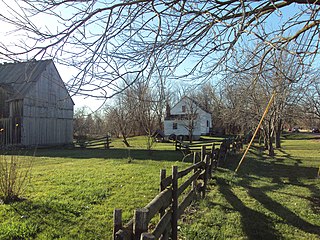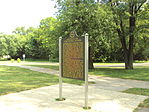
Monroe County is a county in the U.S. state of Michigan. As of the 2020 Census, the population was 154,809. The largest city and county seat is Monroe. The county was established as the second county in the Michigan Territory in 1817 and was named for then-President James Monroe.

Frenchtown Charter Township is a charter township within Monroe County in the U.S. state of Michigan. The population was 21,609 as per the 2020 census.

Monroe is the largest city and county seat of Monroe County, Michigan, United States. The population was 20,462 as of the 2020 census. The city is bordered on the south by Monroe Charter Township, but the two are administered autonomously. Monroe is the core city in the Monroe metropolitan area, which is coterminous with Monroe County and had a population of 154,809 in 2020. Located on the western shores of Lake Erie approximately 20 miles (32 km) northeast of Toledo, Ohio, and 40 miles (64 km) southwest of Detroit, the city is part of the Detroit–Ann Arbor–Flint combined statistical area.

The River Raisin is a river in southeastern Michigan, United States, that flows through glacial sediments into Lake Erie. The area today is an agricultural and industrial center of Michigan. The river flows for almost 139 miles (224 km), draining an area of 1,072 square miles (2,780 km2) in the Michigan counties of Lenawee, Washtenaw, Jackson, Hillsdale, and Monroe County, where its mouth at Lake Erie is located. French settlers named it as La Rivière aux Raisins because of the wild grapes growing along its banks, the French word for grape being raisin. The French term for "raisin" is raisin sec.

The Battles of Frenchtown, also known as the Battle of the River Raisin and the River Raisin Massacre, were a series of conflicts in Michigan Territory that took place from January 18–23, 1813, during the War of 1812. It was fought between the United States of America and a joint force of British and Native Americans near the River Raisin in Frenchtown.

Sandy Creek is an 18.5-mile-long (29.8 km) creek located entirely within Monroe County in the U.S. state of Michigan. The creek rises in London Township in the north-central portion of the county and flows southeast into Lake Erie in Frenchtown Charter Township at Sterling State Park.

This is a list of the National Register of Historic Places listings in Monroe County, Michigan.

William C. Sterling State Park is a public recreation area located in Frenchtown Charter Township with a small portion lying within the city limits of Monroe, Michigan. It is the only Michigan state park located on Lake Erie. The park encompasses 1,300 acres (530 ha) of mostly man-made lagoons and beachfront near the mouth of Sandy Creek. The main attractions at the park include a 256-site campground, beach area, boat launch, and shore fishing lagoons. There are over seven miles (11 km) of biking and hiking trails within the park.
The Army of the Northwest was a U.S. Army unit formed at the outset of the War of 1812 and charged with control of the state of Ohio, the Indiana Territory, Michigan Territory and Illinois Territory.

Paschal Hickman was an American military officer who was killed in the Massacre of the River Raisin, an important event in the War of 1812. Hickman County, Kentucky is named for him.

The Sawyer House, also known as the Sawyer Homestead and in its previous incarnation as the Navarre House, is a city-owned house located at 320 East Front Street in Monroe, Michigan. It was listed as a Michigan Historic Site on June 19, 1975. The house was listed on the National Register of Historic Places on November 23, 1977, and is also part of the larger Old Village Historic District.

The Navarre–Anderson Trading Post is a former trading post complex located at 3775 North Custer Road in Frenchtown Charter Township along the River Raisin in Monroe County, Michigan. It was listed as a Michigan Historic Site on June 16, 1972 and also listed on the National Register of Historic Places on July 31, 1972.
Roundhead, also known as Bark Carrier, Round Head, Stayeghtha, and Stiahta, was an American Indian chief of the Wyandot tribe. He was a strong member of Tecumseh's confederacy against the United States during the War of 1812. He died of unknown natural causes about a month or two before Tecumseh was killed at the Battle of the Thames.

The Hull's Trace North Huron River Corduroy Segment is a portion of Hull's Trace, a military road running from Urbana, Ohio, to Detroit. Hull's Trace was one of the first federal and military roads in the United States. This segment, the only known extant portion of the Trace, contains the remains of a corduroy road, and is located at approximately 36000 W Jefferson Avenue in Brownstown Charter Township, Michigan. The North Huron River Corduroy Segment of Hull's Trace was listed on the National Register of Historic Places in 2010. As of 2014 it has been preserved and made accessible to the public as the Hulls Trace Unit of the River Raisin National Battlefield Park.
Nathaniel Gray Smith Hart was a Lexington, Kentucky lawyer and businessman, who served with the state's volunteer militia during the War of 1812. As Captain of the Lexington Light Infantry from Kentucky, Hart and many of his men were killed in the River Raisin Massacre of January 23, 1813, after being taken prisoner the day before following the Battle of Frenchtown in Michigan Territory.
Benjamin Franklin Graves (1771–1813) was a politician and military leader in early 19th-century Kentucky. During the War of 1812, Graves served as a major in the 2nd Battalion, 5th Kentucky Volunteer regiment. Together with other officers, he commanded Kentucky troops in the Battle of Frenchtown on January 22, 1813, in Michigan Territory. This was part of an effort by Americans to take the British-controlled fort at Detroit, Fort Shelby. This battle had the highest number of American fatalities in the war: of 1,000 American troops, nearly 400 were killed in the conflict, and 547 were taken prisoner. The next day an estimated 30-100 Americans were killed by Native Americans after having surrendered.
The Muskrat French are a cultural group and dialect found in southeastern Michigan along the Detroit River and Lake St. Clair, the western and southern shores of Lake Erie from Monroe County, Michigan to Sandusky, Ohio, and in southwestern Ontario. Their name comes from their tradition of eating muskrat during Lenten Fridays.
Laurent Durocher was an American judge and politician in the U.S. state of Michigan. He was involved in the formation of Monroe County, Michigan, and held numerous official posts during the first decades of its existence, and was also a member of both the Michigan House of Representatives and Michigan Senate.

Hubert Lacroix or Le Croix was an American soldier, trader, and politician who fought in the War of 1812. He was captured by the British following the surrender of Detroit and saved from charges of treason by his friend, the Shawnee chief Tecumseh. Lacroix later served two terms as a member of the Michigan Territorial Council.
William Atherton was an American soldier, rifleman and veteran of the War of 1812 from Shelbyville, Kentucky. He was a private in Captain John Simpson's company of the 1st Rifle Regiment. He served under William Henry Harrison. Atherton wrote a journal that detailed his war service within the Kentucky militia, including their defeat and subsequent massacre at River Raisin by opposing forces, and his subsequent capture and imprisonment.



























